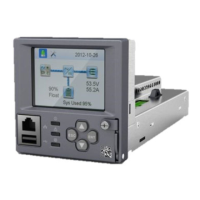Vertiv™ NetSure™ Control Unit (NCU) User Manual
The URL address should include /data; otherwise, it is not processed by this feature. The URL address can contain /data? or /data/?.
The query (input parameters) in the request starts after the question mark (?).
There is an ampersand (&) between each field in the query.
The fields in the query can appear in any order.
The fields in the query are the starting time, the ending time, and 0 to 3 user keys. The starting time is assumed to be 4 hours before
the current time if it is not specified. It can be up to 4 hours in the past. The ending time is assumed to be the current time if it is not
specified. It can be up to 4 hours in the past.
The starting and ending time are specified in one of two ways. First, the time can be specified using “Unix timestamps”. The format is
the number of seconds since Jan 01, 1970 UTC. For example, March 19, 2015 at 7:44UTC is 1426794290. The starting and ending
time using the Unix timestamp format is specified using the field names stime and etime. The time is the local time on the controller.
The starting and ending time can also be specified using YYYY-MM-DD HH:MM:SS. Note that dashes (-) are used instead of slashes
‘/’. The starting and ending time using this format is specified using field names starttime and endtime. The time is the local time on
the controller.
The URL can include 0, 1, 2, or 3 user keys. These keys are ASCII text (A-Z, a-z, 0-9, '-','.' '_', ‘~’), up to 16 characters in length. The keys
are specified as ukey1, ukey2, and ukey3. The query can specify ukey3 without specifying ukey1 and ukey2.
The controller will respond to any abnormal request (two starting times, two ending times, ending time before starting time,
unrecognized keywords, fields that are too long, etc.) with an error response.
Response
The response to the HTTP request is provided as a CSV table. The CSV table starts with a header line. There is one line (row) for
each of the data records.
Error responses are also returned in CSV format.
Response Title
The header line contains the title for each field, enclosed in double quotes (“) and separated by commas. This is the format of the title
line:
“DateTime”, “Epoch Time”, “Status”, “<title1>”, “<title2>”, “<titleN>”, “UserKey1”, ”UserKey2”, “UserKey3”
The <title> fields are the Full English Name of the samples in the table. There is one title for each signal which is sampled. The titles
are enclosed in double quotes.
Response Data
Each row is one line. Each line is separated by a CR/LF.
There is always at least one row in the response.
The fields in the response are DateTime, EpochTime, Status, Signal1…SignalN, Userkey1, Userkey2, Userkey3.
Fields are separated with commas. There is no space after each comma.
The DateTime field is the sample time specified using YYYY-MM-DD HH:MM:SS. The time is the local time on the controller. It is not
enclosed in quotes.

